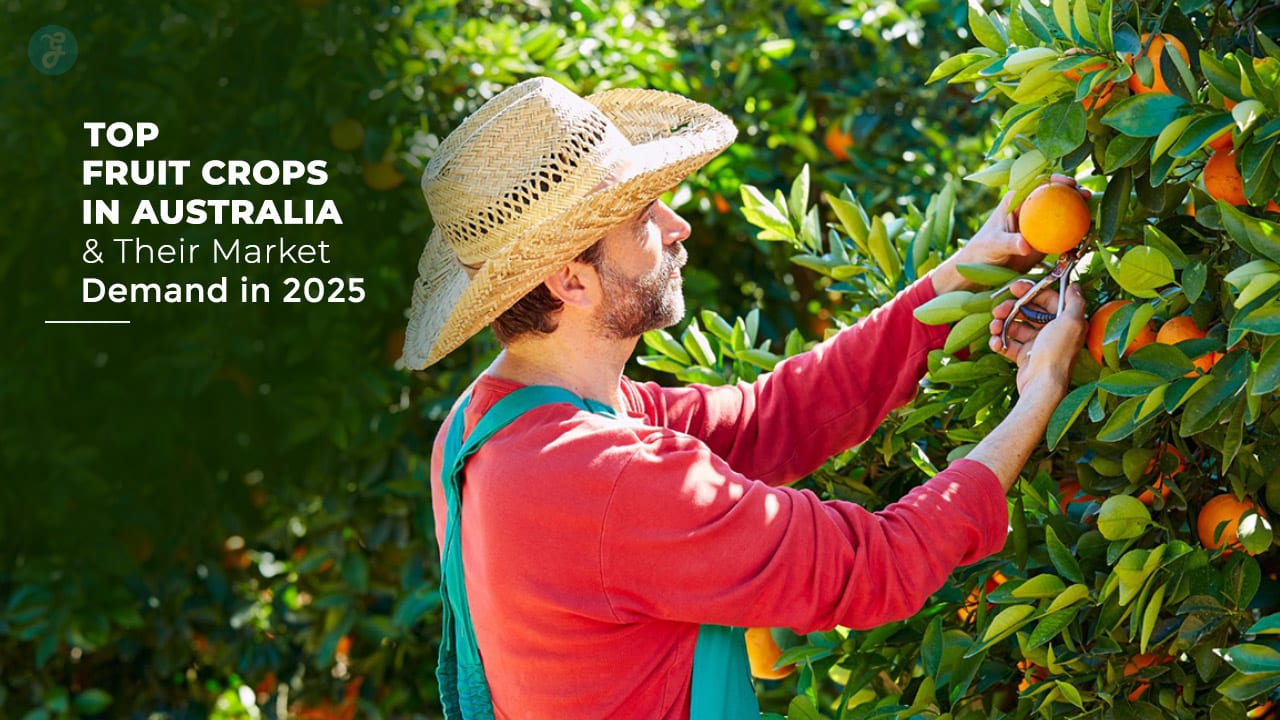Australia’s agriculture sector has long been a cornerstone of its economy, with the fruit industry playing a significant role in both domestic consumption and global exports.
Known for its high-quality produce, sustainable farming practices, and favorable climate, Australia’s fruit market is thriving.
As we look ahead to 2025, understanding the top fruit crops in Australia and their market demand can provide valuable insights for farmers, investors, and consumers alike.
Overview of Australia’s Agriculture Sector
The Australian fruit industry is diverse, ranging from tropical fruits in Queensland to temperate crops in Victoria and Tasmania. It contributes significantly to the economy, with fruits like avocados, mangoes, and berries being major export items.
Sustainable practices and innovative technologies have further enhanced production, ensuring that Australian fruits meet the highest quality standards demanded by global markets.
Rising Trends in the Australian Fruit Market for 2025
Consumer preferences are shifting toward organic, nutrient-rich, and sustainably grown fruits. The demand for exotic and superfoods like berries and avocados continues to rise, driven by health-conscious consumers domestically and internationally. Export markets in Asia and Europe are expected to expand further, bolstered by Australia’s reputation for premium produce.
Factors Driving Market Demand for Australian Fruits
Global Export Opportunities
Australia is a leading exporter of premium fruits, thanks to its stringent quality standards and reliable supply chains. Key markets such as China, India, Japan, and the Middle East are expected to drive demand in 2025, with particular interest in tropical and antioxidant-rich fruits.
Consumer Preferences and Health Trends
The post-pandemic era has heightened awareness about the health benefits of fruits, especially those rich in vitamins and antioxidants. This has led to a surge in demand for berries, citrus fruits, and avocados. Additionally, farm-to-table and organic produce are becoming increasingly popular among Australian consumers.
Technological Advancements in Agriculture
Innovations in irrigation, pest control, and harvesting have transformed fruit production in Australia. Advanced cold storage and supply chain technologies are ensuring that fruits remain fresh during export, while precision farming techniques are boosting yields and reducing waste.
| Factor | Impact on Market Demand |
| Health Trends | Increased demand for antioxidant-rich fruits |
| Export Opportunities | Growth in Asian and European markets |
| Technology Adoption | Improved production and distribution |
Top 10 Fruit Crops in Australia for 2025
1. Avocado
Avocados remain a favorite among Australian consumers and a sought-after export item. The increasing focus on health and wellness has made avocados a staple in many diets, appreciated for their high nutritional value, including healthy fats, vitamins, and minerals.
Their versatility in dishes, ranging from breakfast spreads to salads and smoothies, adds to their appeal. Globally, markets like China and Japan are driving demand for premium-quality Australian avocados, known for their superior taste and texture.
Export opportunities continue to expand as marketing efforts emphasize the fruit’s health benefits, ensuring sustained demand well into 2025. Their popularity in health-conscious markets like China and Japan continues to grow, making them a top fruit crop in Australia.
Production Insights
- Major growing regions: Queensland and New South Wales.
- Innovations in water-efficient farming techniques have increased sustainability.
| Metric | Details |
| Export Volume | Expected increase by 15% |
| Popular Varieties | Hass, Shepard |
2. Mango
Mangoes are a quintessential summer fruit in Australia, loved for their vibrant sweetness and tropical appeal. Domestically, they are a seasonal favorite, often enjoyed fresh or in desserts and beverages.
Internationally, Australian mangoes are in high demand across the Middle East and Asia, where consumers value their exceptional quality. Rising global interest in tropical fruits and health-focused diets is driving export growth, particularly in markets that prize premium produce.
Marketing campaigns highlighting Australian mangoes’ unique flavor profiles and sustainable farming practices are bolstering their reputation, making them a top fruit crop with robust demand in 2025.
Production Insights
- Key regions: Northern Territory, Queensland.
- Advances in ripening and transportation ensure peak freshness.
| Metric | Details |
| Export Markets | China, Japan, Middle East |
| Domestic Sales Growth | 10% year-over-year increase |
3. Berries (Blueberries, Raspberries, Strawberries)
Berries, including blueberries, raspberries, and strawberries, are celebrated as superfoods, making them a high-demand crop both domestically and internationally. Their rich antioxidant and vitamin content appeals to health-conscious consumers, who often incorporate them into smoothies, snacks, and desserts.
Globally, countries like China and Japan are witnessing a surge in demand for Australian berries due to their premium quality and fresh flavor. The versatility of berries, available in fresh, frozen, and processed forms, ensures consistent year-round sales. Innovations in packaging and cold chain logistics are also helping expand export opportunities, solidifying berries’ status as a fast-growing category for 2025.
Production Insights
- Advanced greenhouse techniques are ensuring consistent supply.
- Key growing areas: Victoria, Tasmania.
| Metric | Details |
| Export Demand | Significant growth in Europe and Asia |
| Health Benefits | High in antioxidants and vitamins |
4. Citrus Fruits (Oranges, Mandarins, Lemons)
Rich in vitamin C and antioxidants, citrus fruits have experienced a surge in demand, particularly in the post-pandemic era. Health-conscious consumers prioritize immune-boosting fruits like oranges, mandarins, and lemons, driving both domestic and global sales.
In Australia, citrus fruits are a household staple, widely used in juices, desserts, and savory dishes. Export markets in Asia and the Middle East continue to grow, with Australian citrus prized for its vibrant flavor and quality.
Marketing campaigns emphasizing the health benefits of vitamin C-rich fruits and innovations in extending shelf life further contribute to the robust market demand expected in 2025.
Production Insights
- Key growing regions: Riverina, Sunraysia.
- New techniques extend shelf life, enhancing export potential.
| Metric | Details |
| Key Varieties | Navel oranges, Eureka lemons |
| Export Volume Growth | 12% expected by 2025 |
5. Table Grapes
Table grapes continue to be a consumer favorite due to their crisp texture, natural sweetness, and convenience as a ready-to-eat snack. In domestic markets, they are a staple for households and often featured in gourmet recipes, charcuterie boards, and salads.
Internationally, countries like China, South Korea, and Japan drive significant demand, valuing Australian table grapes for their consistent quality and freshness. The adoption of innovative packaging and cold storage technologies has enhanced export potential, ensuring that grapes arrive in optimal condition. With growing interest in healthy, portable snack options, the demand for table grapes is expected to thrive in 2025.
Production Insights
- Leading regions: Victoria, South Australia.
- Investments in pest-resistant grape varieties are increasing yields.
| Metric | Details |
| Key Export Markets | China, South Korea |
| Production Growth | 8% increase expected |
6. Apples
Apples remain one of the most popular fruits in Australia, cherished for their crisp texture, natural sweetness, and versatility in both fresh and processed forms. Domestic demand is driven by their inclusion in everyday meals, snacks, and beverages like juices and cider.
Internationally, Australian apples are gaining traction in Southeast Asia, with countries like Singapore and Indonesia appreciating premium varieties such as Pink Lady and Bravo for their flavor and aesthetic appeal.
As health trends emphasize the importance of fiber-rich diets, apples continue to be a favored choice, ensuring strong and stable demand in both domestic and export markets by 2025.
Production Insights
- Introduction of organic and premium apple varieties.
- Tasmania and Victoria lead apple production.
| Metric | Details |
| Domestic Market Share | 25% growth in organic sales |
| Export Expansion | Targeting Singapore and Indonesia |
7. Bananas
Bananas maintain their position as a household staple in Australia, celebrated for their affordability, convenience, and nutritional value. Domestically, they are a go-to snack and a key ingredient in smoothies, baked goods, and desserts.
On the export front, nearby markets like Papua New Guinea and Fiji show increasing interest in Australian bananas due to their quality and freshness. Additionally, rising global awareness of bananas’ health benefits, including their potassium and energy-boosting properties, drives sustained demand.
Efforts to enhance production efficiency and expand processing capabilities for banana-based products like chips and purees present new growth opportunities for 2025.
Production Insights
- Key regions: Queensland’s tropical areas.
- Enhanced disease management practices ensure steady supply.
| Metric | Details |
| Domestic Consumption | 90% of production consumed locally |
| Export Markets | Papua New Guinea, Fiji |
8. Stone Fruits (Peaches, Plums, Nectarines)
Stone fruits, including peaches, plums, and nectarines, are highly seasonal yet incredibly popular due to their juicy flavor and versatility. Domestically, they are a summer staple, enjoyed fresh or incorporated into desserts, jams, and salads.
Internationally, Asian markets such as China and South Korea have shown a growing preference for Australian stone fruits, appreciating their premium quality and freshness. Seasonal marketing campaigns and improved transportation logistics ensure that these fruits reach global markets at their peak.
As consumers seek naturally sweet, low-calorie treats, the demand for stone fruits is expected to rise significantly in 2025.
Production Insights
- Major producers: Victoria, New South Wales.
- Improved packaging ensures freshness during exports.
| Metric | Details |
| Export Growth | 15% increase anticipated |
| Seasonal Demand | Peaks during summer months |
9. Pineapples
Pineapples are increasingly in demand for their tropical flavor, versatility, and nutritional benefits. In Australia, they are a popular choice for fresh consumption, as well as for use in desserts, beverages, and savory dishes.
Internationally, the demand for pineapples in processed forms such as juices, canned products, and dried snacks is rising, especially in markets like Asia and the Middle East. Pineapples’ natural sweetness and association with tropical cuisine make them a favorite among consumers seeking exotic fruits.
Sustainable farming practices and innovations in packaging have further bolstered their appeal, ensuring strong market growth for pineapples in 2025.
Production Insights
- Focus on sustainable farming practices.
- Key areas: Queensland’s coastal regions.
| Metric | Details |
| Domestic Sales Growth | 7% increase expected |
| Processed Product Demand | Significant rise in exports |
10. Cherries
Cherries are widely regarded as a luxury fruit, celebrated for their vibrant color, sweet-tart flavor, and association with festive occasions. Domestically, cherries are a holiday favorite, often featured in desserts, gift baskets, and seasonal recipes.
Internationally, markets in China, Japan, and South Korea drive significant demand, particularly during Lunar New Year and other cultural celebrations. Australian cherries are highly valued for their premium quality, benefiting from advanced cold storage and export logistics.
Marketing efforts highlighting their health benefits, including high levels of antioxidants, further enhance their desirability. This combination ensures cherries remain a top-tier export crop in 2025.
Production Insights
- Cold chain advancements improve freshness.
- Leading regions: Tasmania, Victoria.
| Metric | Details |
| Export Markets | China, South Korea, Japan |
| Production Growth | 20% increase anticipated |
Challenges and Opportunities in the Australian Fruit Market
Challenges
- Climate change and extreme weather events are affecting yields.
- Rising labor costs are adding pressure on profitability.
Opportunities
- Global demand for organic produce continues to rise.
- Advanced technologies like AI and IoT can improve efficiency.
Final Thoughts
The top fruit crops in Australia are poised to experience robust demand in 2025, driven by health trends, technological advancements, and global export opportunities.
By focusing on sustainable practices and leveraging innovations, Australia’s fruit industry will continue to thrive, solidifying its position as a leader in premium produce.
Supporting local farmers and exploring investment opportunities in this sector can ensure long-term growth and sustainability.










































